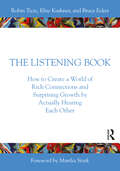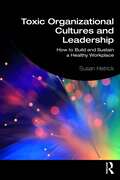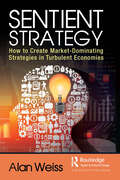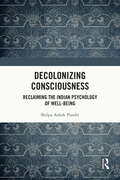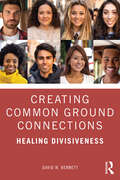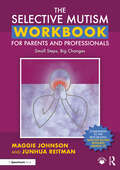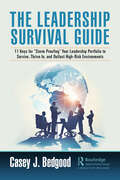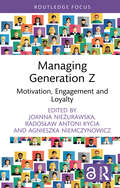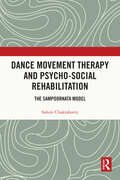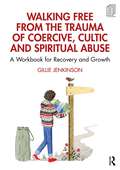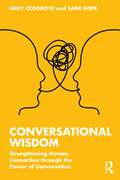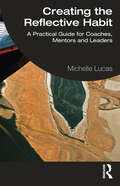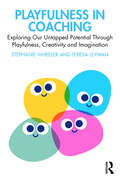- Table View
- List View
The Listening Book: How to Create a World of Rich Connections and Surprising Growth by Actually Hearing Each Other
by Robin Ticic Elise Kushner Bruce EckerSatisfying, secure connection with others depends heavily on how well we listen to each other and respond to what we’ve heard. The Listening Book lays bare the key elements of both deeply attuned and badly misattuned listening in vivid scenes of real-life interactions that capture the emotional impact and give the reader an illuminating "aha" experience. Added to that is a mind-opening account of psychological processes and principles that normally operate from outside of awareness, showing how skillful listening can reveal those dynamics. Beyond even that, such listening can produce interactions that unlock lifelong emotional conditioning to yield liberating change through one of the brain’s most remarkable processes, which neuroscientists call memory reconsolidation. Whether read solo, with a partner, or in a reading group, The Listening Book is for everyone who yearns for deeper emotional connection and closeness, everyone who is at a loss to understand what is interfering, and everyone who is fascinated by the subtle and manifold factors involved in interpersonal communication.
Toxic Organizational Cultures and Leadership: How to Build and Sustain a Healthy Workplace
by Susan HetrickToxic organizational cultures and leadership have led to major reputational failures, with the greatest impact felt by the people who dedicate their careers to working for these organizations. And yet organizations do not become toxic overnight. They do not consciously set out to break rules and regulations, nor do they actively seek wrongdoing. This book defines toxic culture, explains how toxic cultures emerge over time, and provides practical approaches supported by in-depth research for overcoming a toxic culture at the individual, team, and organizational level. Pragmatic and applicable, the book provides a call to action that can be applied in any type of organization. While the role of leadership in toxic cultures is acknowledged, the book sets out four distinct stages to embedding toxic cultures and draws on examples from leading organizations and companies to illustrate each stage. The book then identifies interventions and levers that can be implemented by executives, boards, and HR practitioners to prevent toxicity and to change toxic cultures back to healthy, positive workplaces. Drawing on research and interviews with senior HR leaders and executives, the book provides: An understanding of the four stages of toxic cultures and the impact of performance pressures in driving toxicity An appreciation of the role of senior leadership and personality traits Practical tools and guidance on interventions for practitioners to build and sustain a healthy and positive workplace Senior executives, HR, and organizational development practitioners in local and global organizations spanning a range of industry sectors will find this book invaluable. The book is also highly relevant to consultants working in the field of corporate culture and change.
Toxic Organizational Cultures and Leadership: How to Build and Sustain a Healthy Workplace
by Susan HetrickToxic organizational cultures and leadership have led to major reputational failures, with the greatest impact felt by the people who dedicate their careers to working for these organizations. And yet organizations do not become toxic overnight. They do not consciously set out to break rules and regulations, nor do they actively seek wrongdoing. This book defines toxic culture, explains how toxic cultures emerge over time, and provides practical approaches supported by in-depth research for overcoming a toxic culture at the individual, team, and organizational level. Pragmatic and applicable, the book provides a call to action that can be applied in any type of organization. While the role of leadership in toxic cultures is acknowledged, the book sets out four distinct stages to embedding toxic cultures and draws on examples from leading organizations and companies to illustrate each stage. The book then identifies interventions and levers that can be implemented by executives, boards, and HR practitioners to prevent toxicity and to change toxic cultures back to healthy, positive workplaces. Drawing on research and interviews with senior HR leaders and executives, the book provides: An understanding of the four stages of toxic cultures and the impact of performance pressures in driving toxicity An appreciation of the role of senior leadership and personality traits Practical tools and guidance on interventions for practitioners to build and sustain a healthy and positive workplace Senior executives, HR, and organizational development practitioners in local and global organizations spanning a range of industry sectors will find this book invaluable. The book is also highly relevant to consultants working in the field of corporate culture and change.
Sentient Strategy: How to Create Market-Dominating Strategies in Turbulent Economies
by Alan WeissNo pre-pandemic strategy is effective anymore. None. Not for organizations large or small, for-profit or non-profit, domestic or global. Claims of a "return to normal" or "the new normal" are ridiculous. What we’re facing is really a "new reality," and that reality is the need for agile strategic decisions and pragmatic views of the future. That means that strategy formulation can be reduced to a few days and the view of the future can only be 12–18 months. This is the antithesis of Peter Drucker’s approach to strategy, but his highly effective approach was developed at GM three quarters of a century ago. It’s time to move on. Alan Weiss has developed an original and completely new approach to strategy which thus far has certified over 100 people globally, delivering this approach to scores of firms of all types in four countries. More than two dozen firms are using this approach. Sentient Strategy is based on two modern dimensions: awareness of the environment in which the organization exists and has influence, and consciousness of the impact of actions being considered. The old SWOT (strengths, weaknesses, opportunities, threats) approaches are currently equivalent to riding down the freeway on a horse. We must drop the hubris that has led us to believe we can see years ahead and anticipate what’s coming. No one predicted the Internet No one predicted the latest pandemic. It’s time to turn volatility and disruption on their heads and use them as offensive weapons in the marketplace instead of trying to protect ourselves from them. Imagine a strategy that an organization can formulate in just a day or so, revisit easily and frequently, and design a series of shorter-term, viable futures. "Sentient" means "perceptive" and "self-aware." It doesn’t mean "one size fits all" from a cookie-cutter firm’s approach to strategy. Alan Weiss equips the reader to consider using this approach independently. These are new times—a new reality, a "no normal™"—hence, it’s ridiculous to use old approaches to strategy. There’s a clear reason why Sears didn’t morph into Amazon and why Hertz surrendered its number one spot to Enterprise.
Sentient Strategy: How to Create Market-Dominating Strategies in Turbulent Economies
by Alan WeissNo pre-pandemic strategy is effective anymore. None. Not for organizations large or small, for-profit or non-profit, domestic or global. Claims of a "return to normal" or "the new normal" are ridiculous. What we’re facing is really a "new reality," and that reality is the need for agile strategic decisions and pragmatic views of the future. That means that strategy formulation can be reduced to a few days and the view of the future can only be 12–18 months. This is the antithesis of Peter Drucker’s approach to strategy, but his highly effective approach was developed at GM three quarters of a century ago. It’s time to move on. Alan Weiss has developed an original and completely new approach to strategy which thus far has certified over 100 people globally, delivering this approach to scores of firms of all types in four countries. More than two dozen firms are using this approach. Sentient Strategy is based on two modern dimensions: awareness of the environment in which the organization exists and has influence, and consciousness of the impact of actions being considered. The old SWOT (strengths, weaknesses, opportunities, threats) approaches are currently equivalent to riding down the freeway on a horse. We must drop the hubris that has led us to believe we can see years ahead and anticipate what’s coming. No one predicted the Internet No one predicted the latest pandemic. It’s time to turn volatility and disruption on their heads and use them as offensive weapons in the marketplace instead of trying to protect ourselves from them. Imagine a strategy that an organization can formulate in just a day or so, revisit easily and frequently, and design a series of shorter-term, viable futures. "Sentient" means "perceptive" and "self-aware." It doesn’t mean "one size fits all" from a cookie-cutter firm’s approach to strategy. Alan Weiss equips the reader to consider using this approach independently. These are new times—a new reality, a "no normal™"—hence, it’s ridiculous to use old approaches to strategy. There’s a clear reason why Sears didn’t morph into Amazon and why Hertz surrendered its number one spot to Enterprise.
Decolonizing Consciousness: Reclaiming the Indian Psychology of Well-being
by Shilpa Ashok PanditThe book intertwines several strands of scholarship in Indian Philosophy, contemporary psychology and the lived Indian psychological practice inclusive of Yoga, advaita, tantra and bhakti to engage in an exploration of consciousness, cognitive science and philosophy. The book examines the characteristics of consciousness by situating it in the historical and cultural contexts of Euro-American as well as Asian, particularly Indian philosophical tradition specifically, the Bhakti tradition and creative living. The volume decolonizes the understanding of the ecology of consciousness while accounting for the diverse strands, which have given us a unique understanding of the mind, psychology, cognition and philosophy of the mind. This book will be of interest to students, teachers, and scholars of psychology, consciousness studies, cognitive science, philosophy, social psychology, Yoga studies, and Yoga psychology. It will also be useful for Yoga professionals, social workers, therapists, and anyone who is interested to learn about consciousness.
Decolonizing Consciousness: Reclaiming the Indian Psychology of Well-being
by Shilpa Ashok PanditThe book intertwines several strands of scholarship in Indian Philosophy, contemporary psychology and the lived Indian psychological practice inclusive of Yoga, advaita, tantra and bhakti to engage in an exploration of consciousness, cognitive science and philosophy. The book examines the characteristics of consciousness by situating it in the historical and cultural contexts of Euro-American as well as Asian, particularly Indian philosophical tradition specifically, the Bhakti tradition and creative living. The volume decolonizes the understanding of the ecology of consciousness while accounting for the diverse strands, which have given us a unique understanding of the mind, psychology, cognition and philosophy of the mind. This book will be of interest to students, teachers, and scholars of psychology, consciousness studies, cognitive science, philosophy, social psychology, Yoga studies, and Yoga psychology. It will also be useful for Yoga professionals, social workers, therapists, and anyone who is interested to learn about consciousness.
Creating Common Ground Connections: Healing Divisiveness
by David W. BennettThrough an empathetic and positive approach to interpersonal communication, this book guides readers to build on the skills they already possess to communicate—and connect—with others. Author David W. Bennett, Ph.D. approaches communication with the belief that it is at the heart of any human division. This book helps readers find a way to communicate that will help build understanding regardless of each party’s perspective. Written in an approachable and conversational style, the book includes tips, examples, and concept reviews to easily illustrate communication principles readers can take with them beyond their courses or training sessions. An ideal supplement to courses focusing on skills in interpersonal, professional, or business communication, this book can also be used as a communication primer for students or professionals in any field.
Creating Common Ground Connections: Healing Divisiveness
by David W. BennettThrough an empathetic and positive approach to interpersonal communication, this book guides readers to build on the skills they already possess to communicate—and connect—with others. Author David W. Bennett, Ph.D. approaches communication with the belief that it is at the heart of any human division. This book helps readers find a way to communicate that will help build understanding regardless of each party’s perspective. Written in an approachable and conversational style, the book includes tips, examples, and concept reviews to easily illustrate communication principles readers can take with them beyond their courses or training sessions. An ideal supplement to courses focusing on skills in interpersonal, professional, or business communication, this book can also be used as a communication primer for students or professionals in any field.
The Selective Mutism Workbook for Parents and Professionals: Small Steps, Big Changes
by Maggie Johnson Junhua ReitmanThis workbook provides hands-on Activities, Strategies, planning sheets and progress trackers for use with children with selective mutism at home, at school and in the wider community. Written by selective mutism expert Maggie Johnson and parent coach Junhua Reitman, the workbook includes first-hand accounts of how children can overcome SM successfully using the Activities and Strategies described in this book. Activities are organised around the daily routines of school and family life and each Activity is broken into a progression of small steps with appropriate Strategies and an accompanying record sheet to track progress. Activities include: • Using the toilet at school • Attending social gatherings • Organising a successful playdate • Initiating conversation • Talking in the classroom • Eating with peers This workbook is essential reading for parents, professionals and anyone who is looking for a toolkit for selective mutism. It also provides a useful extension to The Selective Mutism Resource Manual, 2nd edition, focusing on the ‘how’ to complement the manual’s ‘what’ and ‘why’. Small steps really do lead to big changes but taking the first step can be the most difficult. This book helps you make that first step.
The Selective Mutism Workbook for Parents and Professionals: Small Steps, Big Changes
by Maggie Johnson Junhua ReitmanThis workbook provides hands-on Activities, Strategies, planning sheets and progress trackers for use with children with selective mutism at home, at school and in the wider community. Written by selective mutism expert Maggie Johnson and parent coach Junhua Reitman, the workbook includes first-hand accounts of how children can overcome SM successfully using the Activities and Strategies described in this book. Activities are organised around the daily routines of school and family life and each Activity is broken into a progression of small steps with appropriate Strategies and an accompanying record sheet to track progress. Activities include: • Using the toilet at school • Attending social gatherings • Organising a successful playdate • Initiating conversation • Talking in the classroom • Eating with peers This workbook is essential reading for parents, professionals and anyone who is looking for a toolkit for selective mutism. It also provides a useful extension to The Selective Mutism Resource Manual, 2nd edition, focusing on the ‘how’ to complement the manual’s ‘what’ and ‘why’. Small steps really do lead to big changes but taking the first step can be the most difficult. This book helps you make that first step.
The Leadership Survival Guide: 11 Keys for "Storm Proofing" Your Leadership Portfolio to Survive, Thrive In, and Outlast High-Risk Environments
by Casey J. BedgoodCurrently, change is the new normal. As change grows, so does risk. But how will leaders understand the risk if they don’t measure it? In short, they won’t. The reality is that ignorance is never bliss. What leaders and their organizations don’t know will eventually impact them and their customers. Thus, situational awareness, forethought, and preparation are now key competencies for leaders to survive in high-risk environments. In this book, readers will learn the basics of leadership time management, the disruptability quotient, the leadership “canary” and why it’s just as important to leaders as it was to coal miners, and the slippery slope of change management (do we improve, change, or model the current state?), signals of leadership maturity and false positives, mastering the art of organizational knowledge, the pearls, and pitfalls of leadership rebranding, and the risk of non-utilized talent. Why aren’t current leaders required to undergo “storm proofing” from an operational perspective? As many of us experienced in various academic programs, the main foci are technical skills in management, organizational theory, data analysis, and many of the traditional leadership training courses. But, what happens when a leadership storm appears such as an unprecedented pandemic or supply chain crisis, or talent gaps where workers are not available to complete the basic services humanity relies on daily? Most leaders were not and are not prepared for today’s storms. The result is reactive leadership, higher-than-expected risk propositions, and disruptive transformations that force leaders from their perches to find the next best role their skillsets will buy. This book is for leaders and professionals who are currently, or will be leading teams, divisions, and organizations. Its purpose is to provide practical guidance on how leaders can “stormproof” their portfolios. Thus, they will be able to survive, thrive in, and outlast high-risk leadership storms that will overwhelm their less-prepared peers.
The Leadership Survival Guide: 11 Keys for "Storm Proofing" Your Leadership Portfolio to Survive, Thrive In, and Outlast High-Risk Environments
by Casey J. BedgoodCurrently, change is the new normal. As change grows, so does risk. But how will leaders understand the risk if they don’t measure it? In short, they won’t. The reality is that ignorance is never bliss. What leaders and their organizations don’t know will eventually impact them and their customers. Thus, situational awareness, forethought, and preparation are now key competencies for leaders to survive in high-risk environments. In this book, readers will learn the basics of leadership time management, the disruptability quotient, the leadership “canary” and why it’s just as important to leaders as it was to coal miners, and the slippery slope of change management (do we improve, change, or model the current state?), signals of leadership maturity and false positives, mastering the art of organizational knowledge, the pearls, and pitfalls of leadership rebranding, and the risk of non-utilized talent. Why aren’t current leaders required to undergo “storm proofing” from an operational perspective? As many of us experienced in various academic programs, the main foci are technical skills in management, organizational theory, data analysis, and many of the traditional leadership training courses. But, what happens when a leadership storm appears such as an unprecedented pandemic or supply chain crisis, or talent gaps where workers are not available to complete the basic services humanity relies on daily? Most leaders were not and are not prepared for today’s storms. The result is reactive leadership, higher-than-expected risk propositions, and disruptive transformations that force leaders from their perches to find the next best role their skillsets will buy. This book is for leaders and professionals who are currently, or will be leading teams, divisions, and organizations. Its purpose is to provide practical guidance on how leaders can “stormproof” their portfolios. Thus, they will be able to survive, thrive in, and outlast high-risk leadership storms that will overwhelm their less-prepared peers.
Managing Generation Z: Motivation, Engagement and Loyalty (Routledge Open Business and Economics)
Generation Z (Gen Z) is the young generation born between the mid-1990s and 2010s. They are now entering the market and starting their first jobs. Therefore, managers must shape the company workplace environment to encourage young employees to work efficiently and connect their future with the company. Only then will both managers and employees share mutual satisfaction from collaboration and aim at the common target, which should be the prosperity of the company. This book presents research results and techniques for analysing the working expectations and needs of Gen Z. The analyses were made in various countries in Europe: The Czech Republic, Latvia, Poland, and Portugal. The book contains chapters that present the analysis results and technical chapters that outline modern methods of analysis of management data, including tutorial chapters on machine learning, which currently makes a strong appearance in research in various disciplines. This volume will be of interest to researchers, academics, practitioners, and students in the fields of management studies, research methods, and human resource management.
Managing Generation Z: Motivation, Engagement and Loyalty (Routledge Open Business and Economics)
by Joanna Nieżurawska Radosław Antoni Kycia Agnieszka NiemczynowiczGeneration Z (Gen Z) is the young generation born between the mid-1990s and 2010s. They are now entering the market and starting their first jobs. Therefore, managers must shape the company workplace environment to encourage young employees to work efficiently and connect their future with the company. Only then will both managers and employees share mutual satisfaction from collaboration and aim at the common target, which should be the prosperity of the company. This book presents research results and techniques for analysing the working expectations and needs of Gen Z. The analyses were made in various countries in Europe: The Czech Republic, Latvia, Poland, and Portugal. The book contains chapters that present the analysis results and technical chapters that outline modern methods of analysis of management data, including tutorial chapters on machine learning, which currently makes a strong appearance in research in various disciplines. This volume will be of interest to researchers, academics, practitioners, and students in the fields of management studies, research methods, and human resource management.
Dance Movement Therapy and Psycho-social Rehabilitation: The Sampoornata Model
by Sohini ChakrabortyThis book looks at the psychotherapeutic effects of Dance Movement Therapy (DMT) with a focus on the experiences of survivors of gender-based violence and their social development, psycho-social rehabilitation, and reintegration within society. The author, a sociologist and dancer, uses a model she calls Sampoornata— or Fulfilment, to merge sociology and dance in order to help survivors of sexual violence overcome their trauma. Sampoornata was developed to help survivors of gender-based violence and trafficking, by focusing on their specific needs, and helping them to express themselves and overcome emotional and psychological pain. Through interviews with and detailed narratives of survivors, the book takes the readers through the development of the model, its implementation, practice, and impact on their lives. Situated within the social, cultural, as well as geographical context of India, the book is an important resource for rethinking the creative approaches, theories, and practice of DMT worldwide. This book will be of interest to researchers and students of psychology, psychotherapy, dance and movement studies, and to those who work with dance and movement therapy. It will also be useful for professionals working in the areas of gender violence, trafficking, trauma, psycho-social rehabilitation, and well-being.
Dance Movement Therapy and Psycho-social Rehabilitation: The Sampoornata Model
by Sohini ChakrabortyThis book looks at the psychotherapeutic effects of Dance Movement Therapy (DMT) with a focus on the experiences of survivors of gender-based violence and their social development, psycho-social rehabilitation, and reintegration within society. The author, a sociologist and dancer, uses a model she calls Sampoornata— or Fulfilment, to merge sociology and dance in order to help survivors of sexual violence overcome their trauma. Sampoornata was developed to help survivors of gender-based violence and trafficking, by focusing on their specific needs, and helping them to express themselves and overcome emotional and psychological pain. Through interviews with and detailed narratives of survivors, the book takes the readers through the development of the model, its implementation, practice, and impact on their lives. Situated within the social, cultural, as well as geographical context of India, the book is an important resource for rethinking the creative approaches, theories, and practice of DMT worldwide. This book will be of interest to researchers and students of psychology, psychotherapy, dance and movement studies, and to those who work with dance and movement therapy. It will also be useful for professionals working in the areas of gender violence, trafficking, trauma, psycho-social rehabilitation, and well-being.
Walking Free from the Trauma of Coercive, Cultic and Spiritual Abuse: A Workbook for Recovery and Growth
by Gillie JenkinsonThis is an interactive self-help workbook and psychological road map to enable survivors of coercive, cultic and spiritual abuse to find healing, recovery and growth. This book provides a comprehensive guide to recovery, based on a tested model of post-cult counselling, and years of research and clinical experience. It is designed to help survivors of diverse abusive settings, including religious and spiritual, political, gangs, business, therapy and wellness and one-on-one relationships. The reader follows a beautifully illustrated journey through four Phases of recovery and growth, one Milestone at a time, to make sense of what has happened to them, learn how to walk free from psychological control and find resources for healing. The author includes stories from her own experience, detailing her path towards recovery and how she learned to come to terms with and overcome what happened to her. Written in accessible language, this workbook serves as both a self-help book for survivors and former members, and a guide for therapists working with them.
Walking Free from the Trauma of Coercive, Cultic and Spiritual Abuse: A Workbook for Recovery and Growth
by Gillie JenkinsonThis is an interactive self-help workbook and psychological road map to enable survivors of coercive, cultic and spiritual abuse to find healing, recovery and growth. This book provides a comprehensive guide to recovery, based on a tested model of post-cult counselling, and years of research and clinical experience. It is designed to help survivors of diverse abusive settings, including religious and spiritual, political, gangs, business, therapy and wellness and one-on-one relationships. The reader follows a beautifully illustrated journey through four Phases of recovery and growth, one Milestone at a time, to make sense of what has happened to them, learn how to walk free from psychological control and find resources for healing. The author includes stories from her own experience, detailing her path towards recovery and how she learned to come to terms with and overcome what happened to her. Written in accessible language, this workbook serves as both a self-help book for survivors and former members, and a guide for therapists working with them.
Conversational Wisdom: Strengthening Human Connection through the Power of Conversation
by Emily Cosgrove Sara HopeConversation: the heartbeat of our organisations. Right now, we’re at risk of losing the art of doing it well. We need to radically change how we talk to each other, to create workplaces where people feel they belong and can thrive. This book will help you understand how to grow your conversational wisdom to create more inclusive and collaborative environments and to make work more meaningful. Conversations carry the greatest potential to impact culture, performance, brand, and engagement. Yet conversation is an under-rated and under-developed skill. Emily Cosgrove and Sara Hope have spent the last 25 years helping people and organisations strengthen human connection through the power of conversation. Drawing on their experience of working with organisations from global jewellers to charities, professional services to B Corporations, they share a wealth of tips, tools, stories, and case studies. Written in a style that is easy to understand, they offer advice on how to get the best out of conversations and get underneath some of the challenges we all face. This is essential reading for learning and development experts, people leaders, coaches and mentors, and HR managers.
Conversational Wisdom: Strengthening Human Connection through the Power of Conversation
by Emily Cosgrove Sara HopeConversation: the heartbeat of our organisations. Right now, we’re at risk of losing the art of doing it well. We need to radically change how we talk to each other, to create workplaces where people feel they belong and can thrive. This book will help you understand how to grow your conversational wisdom to create more inclusive and collaborative environments and to make work more meaningful. Conversations carry the greatest potential to impact culture, performance, brand, and engagement. Yet conversation is an under-rated and under-developed skill. Emily Cosgrove and Sara Hope have spent the last 25 years helping people and organisations strengthen human connection through the power of conversation. Drawing on their experience of working with organisations from global jewellers to charities, professional services to B Corporations, they share a wealth of tips, tools, stories, and case studies. Written in a style that is easy to understand, they offer advice on how to get the best out of conversations and get underneath some of the challenges we all face. This is essential reading for learning and development experts, people leaders, coaches and mentors, and HR managers.
Creating the Reflective Habit: A Practical Guide for Coaches, Mentors and Leaders
by Michelle LucasReflection is a critical skill which can enhance the quality of our professional and domestic lives. Yet in a world of "busy," reflective practice often falls to the bottom of the list. We are not alone in the struggle to use the pause button well. This book is here to help. The book offers a practical toolkit which shows you how to create a sustainable reflective habit. We begin by exploring the meaning and territory of reflection, drawing from the literature to provide context and understanding. The following chapters contain prompts and exercises which will appeal to different processing preferences. The intention throughout this book is firstly, to show that reflection means so much more than journaling, and secondly, to encourage an appetite for experimentation that results in a desire to reflect on a regular and sustainable basis. We invite you into an immersive experience, playing with the multitude of reflective possibilities on offer. It is only through repeated trial and error, enlightenment and frustration that we will come to create our own reflective habit. Written by a coach and coach supervisor, this practical book is an invaluable resource for helping practitioners, but will also be immensely helpful to anyone and everyone who wants to get their pause button in good working order. The book also provides Learning & Development professionals with a suite of tools and materials to help build the reflective practice skill set in their organisation.
Creating the Reflective Habit: A Practical Guide for Coaches, Mentors and Leaders
by Michelle LucasReflection is a critical skill which can enhance the quality of our professional and domestic lives. Yet in a world of "busy," reflective practice often falls to the bottom of the list. We are not alone in the struggle to use the pause button well. This book is here to help. The book offers a practical toolkit which shows you how to create a sustainable reflective habit. We begin by exploring the meaning and territory of reflection, drawing from the literature to provide context and understanding. The following chapters contain prompts and exercises which will appeal to different processing preferences. The intention throughout this book is firstly, to show that reflection means so much more than journaling, and secondly, to encourage an appetite for experimentation that results in a desire to reflect on a regular and sustainable basis. We invite you into an immersive experience, playing with the multitude of reflective possibilities on offer. It is only through repeated trial and error, enlightenment and frustration that we will come to create our own reflective habit. Written by a coach and coach supervisor, this practical book is an invaluable resource for helping practitioners, but will also be immensely helpful to anyone and everyone who wants to get their pause button in good working order. The book also provides Learning & Development professionals with a suite of tools and materials to help build the reflective practice skill set in their organisation.
Playfulness in Coaching: Exploring Our Untapped Potential Through Playfulness, Creativity and Imagination
by Stephanie Wheeler Teresa LeymanWhat do we mean by playfulness? Playfulness and play are no longer seen as only of benefit to children’s learning and development, but are being used increasingly for coaching adults in the context of serious challenges and issues. Benefits include better communication, understanding, self-awareness, relationship-building, creativity, ideation and innovation in a business environment. This book is the first to introduce and expand on the idea of playfulness as an approach in coaching. Playfulness in Coaching fully explains the serious role of playfulness and provides the why and the how for new and experienced coaches. Using case studies throughout, the book takes a broad and evidence-led look at the relevant areas of playfulness in coaching: contracting, developing insights, forming direct communications, how to prime the coach and the client for playfulness, identifying and overcoming barriers, assessing risks, and closing a session. It is packed with theory, research, stories from practice, ideas and inspiration for understanding and applying playfulness in life and work. This will be an invaluable resource for coaches, particularly those with experience who are moving towards intermediate and mastery level. The book has been written with coaches working with corporate clients in mind, particularly in the context of challenges in a VUCA environment. It will also be relevant to HR and Learning and Development managers who source coaches for organisations and oversee internal coaches, as well as managers-as-coaches, life coaches and mental health professionals.
Playfulness in Coaching: Exploring Our Untapped Potential Through Playfulness, Creativity and Imagination
by Stephanie Wheeler Teresa LeymanWhat do we mean by playfulness? Playfulness and play are no longer seen as only of benefit to children’s learning and development, but are being used increasingly for coaching adults in the context of serious challenges and issues. Benefits include better communication, understanding, self-awareness, relationship-building, creativity, ideation and innovation in a business environment. This book is the first to introduce and expand on the idea of playfulness as an approach in coaching. Playfulness in Coaching fully explains the serious role of playfulness and provides the why and the how for new and experienced coaches. Using case studies throughout, the book takes a broad and evidence-led look at the relevant areas of playfulness in coaching: contracting, developing insights, forming direct communications, how to prime the coach and the client for playfulness, identifying and overcoming barriers, assessing risks, and closing a session. It is packed with theory, research, stories from practice, ideas and inspiration for understanding and applying playfulness in life and work. This will be an invaluable resource for coaches, particularly those with experience who are moving towards intermediate and mastery level. The book has been written with coaches working with corporate clients in mind, particularly in the context of challenges in a VUCA environment. It will also be relevant to HR and Learning and Development managers who source coaches for organisations and oversee internal coaches, as well as managers-as-coaches, life coaches and mental health professionals.
